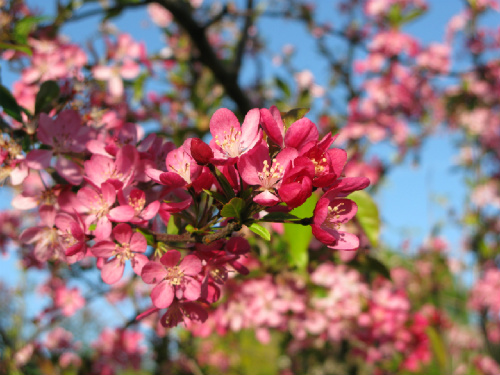Cherry trees can be a beautiful addition to your property. Unfortunately, they can be difficult to grow in Minnesota. Cherry trees require bit more TLC than other fruit trees, such as apple trees, but by taking the right steps your trees can thrive and produce healthy fruit.
First Steps
The first step to controlling cherry tree diseases and pests is providing the tree with an optimal environment for growth. This means giving the tree adequate sunlight and soil that contains the proper pH levels for the tree to stay healthy. Without giving your cherry tree a healthy base, it is difficult to manage disease and pests (should they arise).
Most tree nurseries will have cherry trees that are adapted to your area but you should still make sure the tree can thrive on your property. Also when choosing a tree, make sure the roots aren’t dry. You’ll also want to cut back the tree, as shorter trees are easier to manage and can better establish themselves.
Cherry Tree Maintenance
Once the tree is a part of your property, make sure it is pruned regularly, especially spots that are dead or dying. You will want to remove the dead fruit, even if it has already fallen from the tree. Damaged fruit, even when they’re on the ground, can attract other pests or diseases. Fertilization is also an essential part of keeping a cherry tree healthy.
Applying fungicides and pesticides is another effective way to reduce the risks that come with owning cherry trees. Lime solutions, applied during the spring and winter, are an option made popular by their lacking of harsh chemicals. You can visit your local lawn and garden care provider for other fungicide and pesticide solutions. Besides treatment applied as necessary, warm and damp conditions are conducive to disease and pests. Also, increased applications will be necessary during humid, wet conditions.
Cherry Tree Diseases
- Black Knot attacks the branches of cherry trees, causing thick black knots. It’s best to prune black knot as it appears, accompanied by a fungicide spray at the site of any new growth.
- Brown Knot forms cankers and fuzzy growths on the fruit of the tree. If you have an established tree and know when the harvest will begin, spray fungicide several weeks beforehand. Also, if there is frequent rain, spray every week to keep the disease at bay.
- Cherry Leaf Spot often occurs in humid areas and affects the leaves, twigs and stems. It causes dark spots and yellowing to appear.
Cherry Tree Pests
Cherry trees often have pests similar to those on peach and plum trees. Pests that are common with cherry trees include:
- Aphids are small, soft bugs that cause deformed leaves. They are pear-shaped and come in a variety of colors.
- Borers, particularly Shothole and Peachtree, burrow under the bark of cherry trees and cause wilt and discoloration in the leaves of cherry trees.
- Fruit Flies are very small black flies that commonly attack cherry and black cherry trees. They most often appear during the months of May through July.
Before Applying Treatment
When spraying for pests and diseases, always read the container for instructions on storage and usage. And while this may sound like common sense, make sure you understand the problem before you treat it. You might be surprised to find out how often property owners buy the first treatment they see. If you’re concerned about chemicals or like putting treatments together on your own, look into homemade insecticides that use household items such as peppermint oil or hot peppers.
Not concerned about cherry tree diseases? Check out our blog on the Top Tree Diseases You Need To Know About. If you’re concerned about a tree on your property, give us a call at 952-473-0534.








